
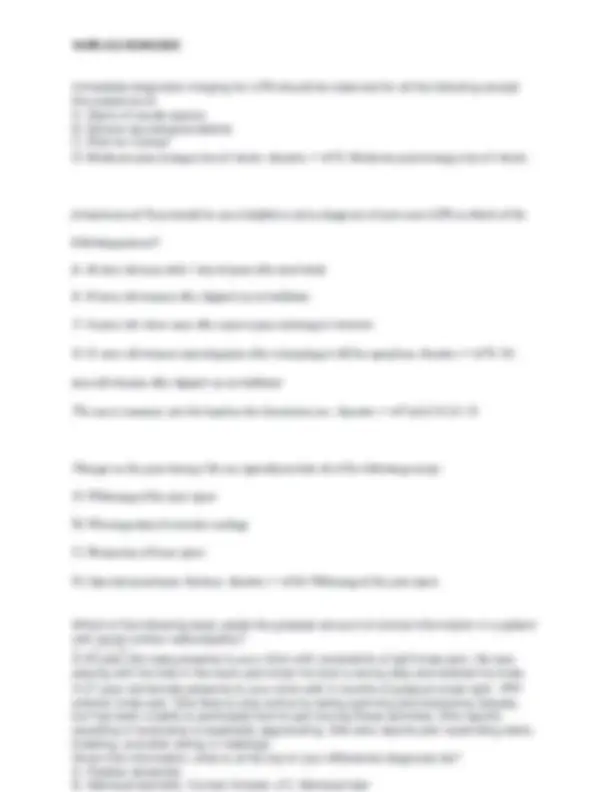
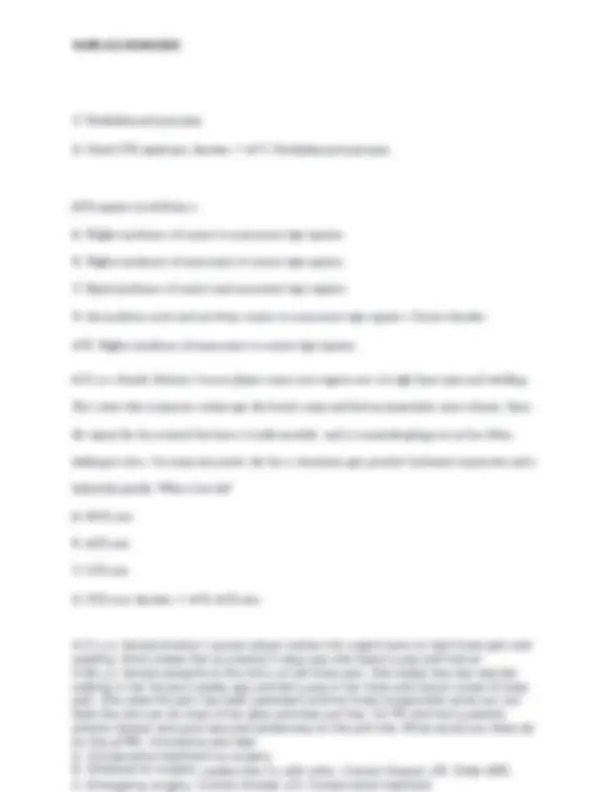
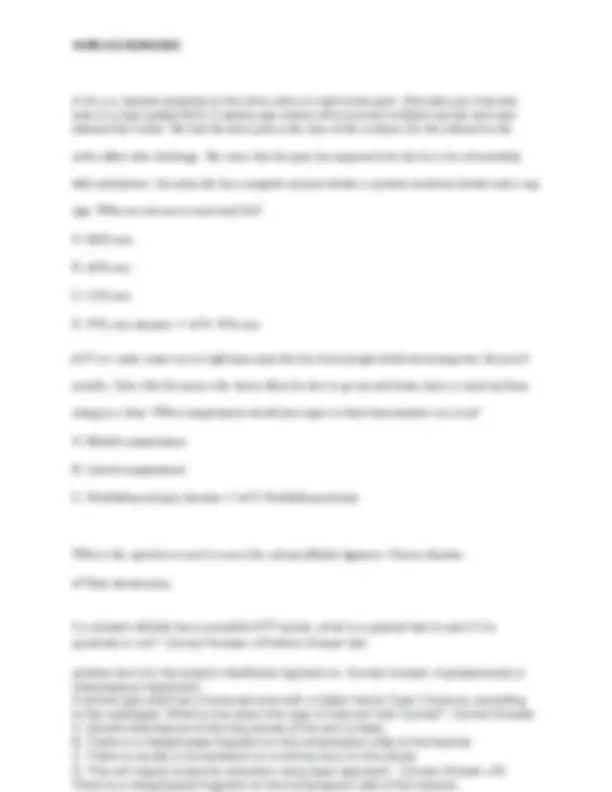
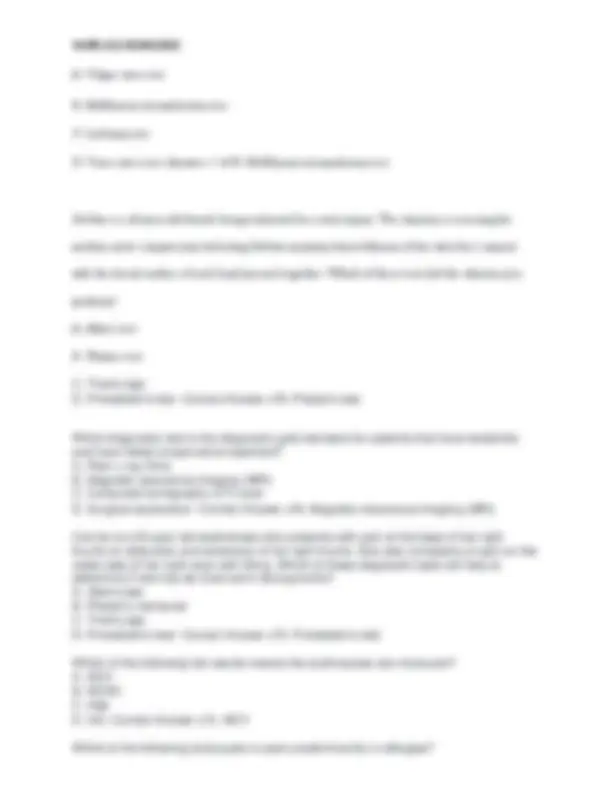
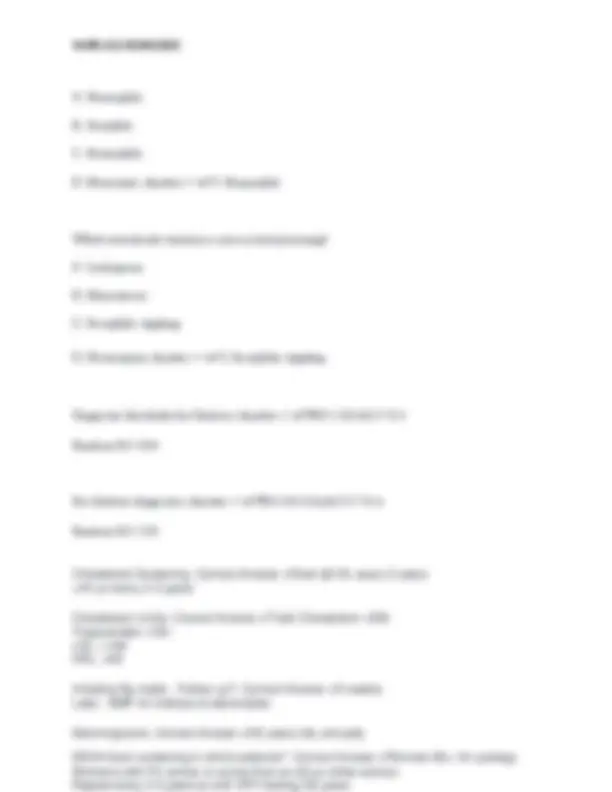
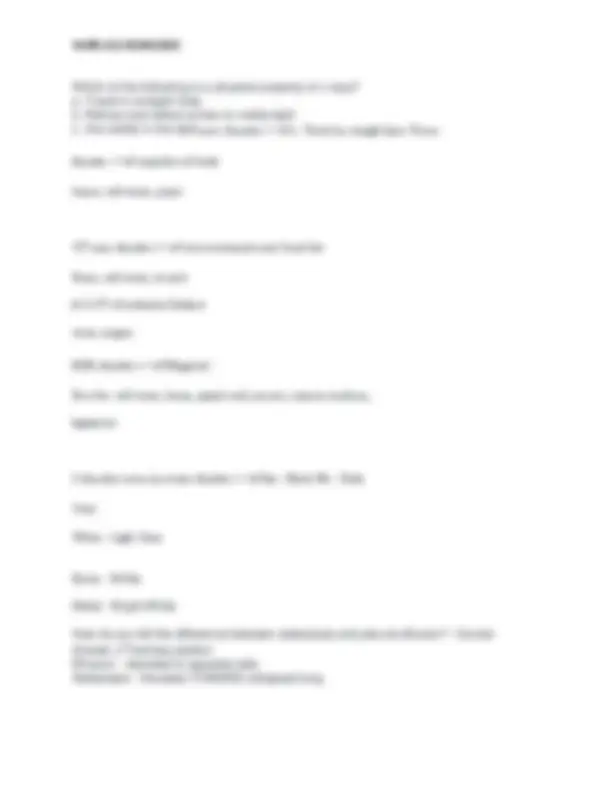
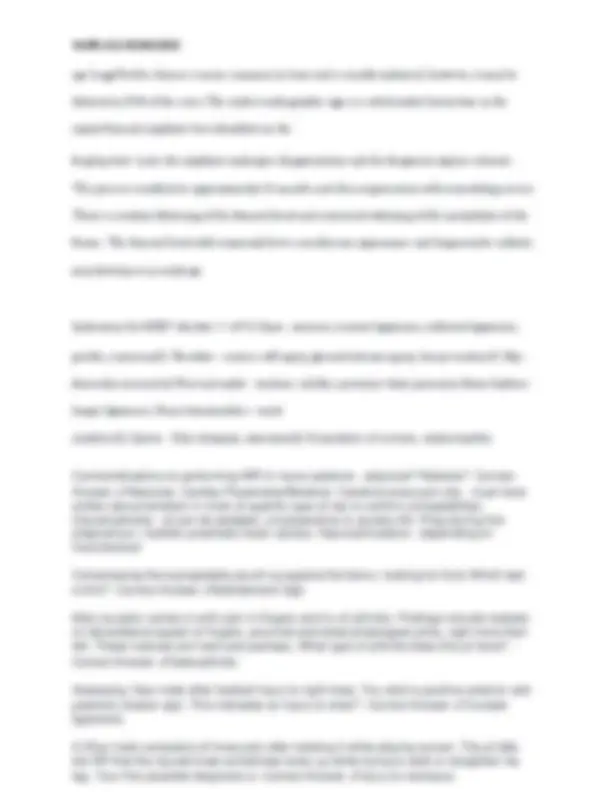
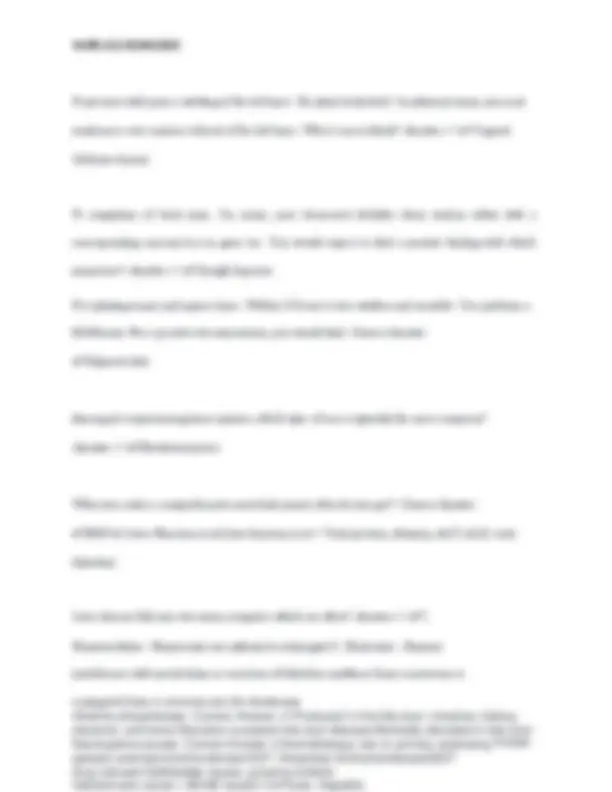
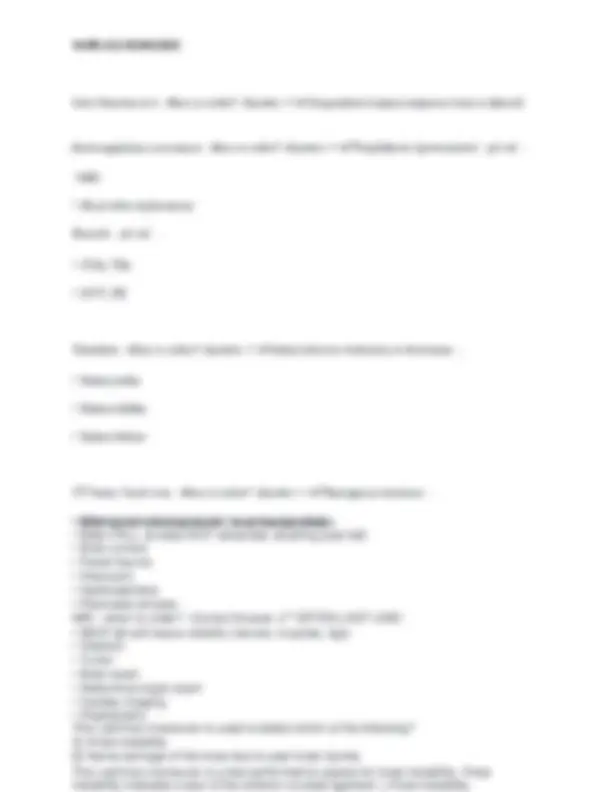
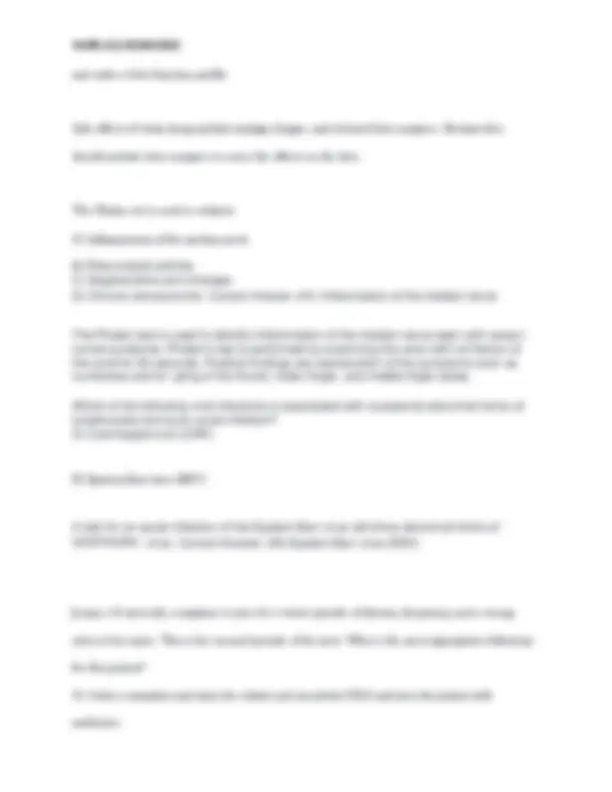
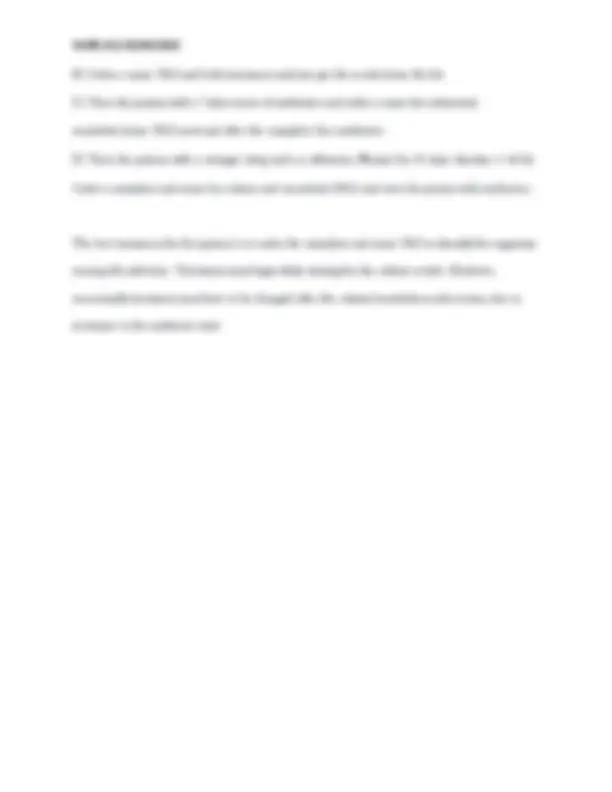
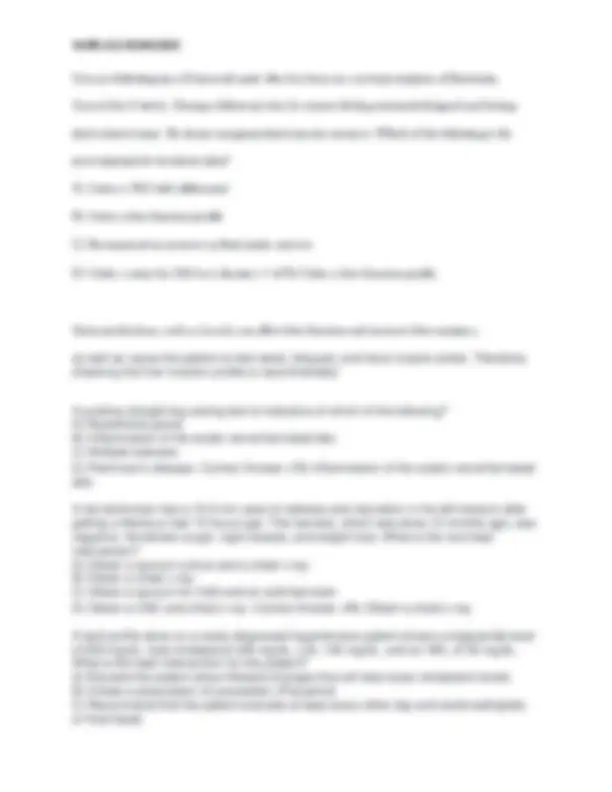
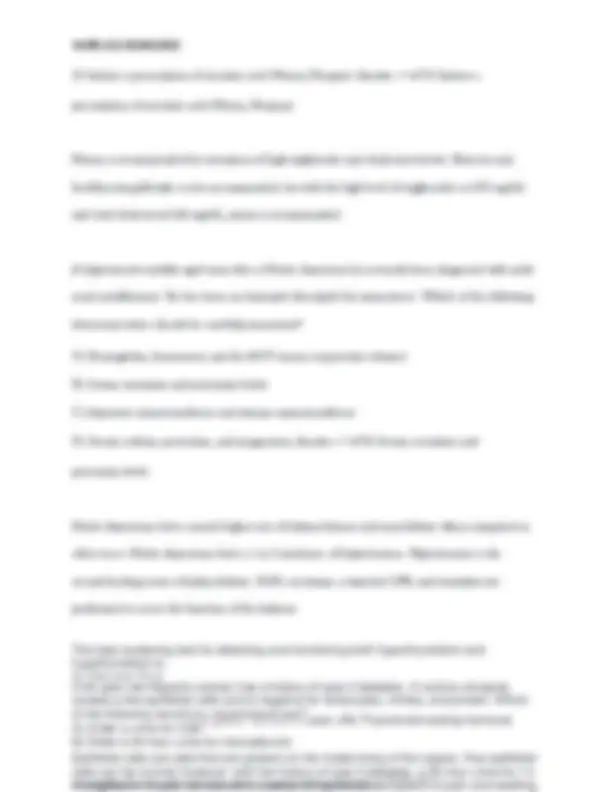
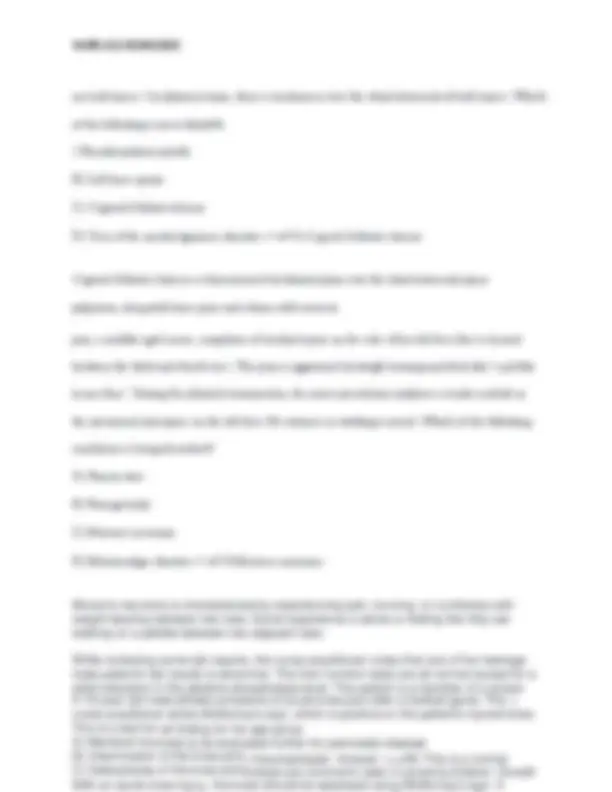



Study with the several resources on Docsity

Earn points by helping other students or get them with a premium plan


Prepare for your exams
Study with the several resources on Docsity

Earn points to download
Earn points by helping other students or get them with a premium plan
Community
Ask the community for help and clear up your study doubts
Discover the best universities in your country according to Docsity users
Free resources
Download our free guides on studying techniques, anxiety management strategies, and thesis advice from Docsity tutors
A comprehensive set of questions and answers related to the nurs 612 advanced health assessment course. It covers various topics, including musculoskeletal injuries, osteoarthritis, and neurological conditions. Designed to help students prepare for their exams by providing a realistic assessment of their knowledge and understanding of the subject matter.
Typology: Exams
1 / 23

This page cannot be seen from the preview
Don't miss anything!
















Which of the following joints is most likely to be affected by OA? A. Wrists B. Elbows C. metacarpophalangeal joint The most common type of injury causing a sport-related meniscal tear involves A. Twisting of the knee B. Hyperextension of the knee D. DIP Joint - Correct Answer ✔D. DIP Joint D. Knee often locks or pop is heard B. Joint Effusion crepitus E. redness and heat over the anterior and posterior knee - Correct Answer ✔A. Coarse D. Knee often locks or a pop is heard C. Warm joint B. Joint Effusion A. Coarse crepitus Clinical finding of the knee in a patient with OA include which of the following (SATA) D. Dupuytrens contracture - Correct Answer ✔B. Bouchards nodes C. Hallus valgus B. Bouchards nodes A. Herberdens Nodes Deformity of the PIP joints found in an elderly patient with OA are knowns as rotated Answer ✔B. Moving the knee from full extension with hip flexed and knee externally D. Having the patient stand with knee fully extended and then rotate the trunk - Correct C. having the individual attempt to duck walk B. Moving the knee from full extension with hip flexed and knee externally rotated A. Compressing the knee while externally or internally rotating the tibia The McMurray test is performed by
C. Repetadive striking impact on the knee D. Unknown origin - Answer:->>✔A. Twisting of the knee A patient with a complete meniscal tear will present with: A. Joint Effusion B. Heat over the knee C. Inability to kneel D. Loss of smooth joint movement - Answer:->>✔C. Inability to kneel For a patient with a suspected meniscal tear with an xray that does not reveal acute changes, the preferred next step is: A. Order an MRI B. Order an US C. Advise that arthroscopy is next step D. Consider an alternate DX as meniscal tear is unlikely - Answer:->>✔A. MRI forced flexion of the wrists. The Phalen test is described as: - Correct Answer ✔Reproduction of symptoms with median nerve is tapped. The tinel test is best described as: - Correct Answer ✔abnormal tingling when the D. S2 and S3 - Correct Answer ✔C. L5-S C. L5 and S B. L3 and L A. L1 and L nerve roots? With the straight-leg-raising test, the NP is evaluating tension on which of the following D. Sciatic nerve entrapment - Correct Answer ✔Cauda Equina Syndrome C. Vertebral fracture B. Muscular sprain A. Cauda equina syndrome bowel and bladder function. This most likely indicates: You see a 48 - year-old woman who reports LBP. She mentions new onset of loss of
C. Patellofemoral joint pain D. Distal ITB syndrome - Answer:->>✔C. Patellofemoral joint pain ACL injuries result from a: A. Higher incidence of contact vs noncontact type injuries B. Higher incidence of noncontact vs contact type injuries C. Equal incidence of contact and noncontact type injuries D. An insidious onset and not from contact or noncontact type injuries - Correct Answer ✔B. Higher incidence of noncontact vs contact type injuries A 21 y.o. female division I soccer player comes into urgent care c/o right knee pain and swelling. She's states that at practice 4 days ago she heard a pop and had an immediate onset of pain. Since the injury she has noticed her knee is really unstable and is constantly giving out on her when walking to class. On exam you notice she has a bent-knee gait, positive Lachman's maneuver and a ballotable patella. What is her dx? A. MCL tear B. ACL tear C. LCL tear D. PCL tear - Answer:->>✔B. ACL tear T/F: MRI is the confirmatory test for ACL and PCL injuries - Correct Answer ✔True Immobilize and refer D. Straight leg cast for 4 weeks then f/u with ortho - Correct Answer ✔B. Order MRI, C. Send to ER for emergency surgery B. Order MRI, Immobilize and refer A. NSAIDs, Splint and f/u in 2 weeks you do for this pt? a bent-knee gait, positive Lachman's maneuver and a ballotable patella. What should and is constantly giving out on her when walking to class. On exam you notice she has immediate onset of pain. Since the injury she has noticed her knee is really unstable swelling. She's states that at practice 4 days ago she heard a pop and had an A 21 y.o. female division I soccer player comes into urgent care c/o right knee pain and C. Emergency surgery - Correct Answer ✔A. Conservative treatment B. Schedule for surgery A. Conservative treatment for this pt? anterior drawer and pivot test and tenderness on the joint line. What would you likely do feels like she can do most of her daily activities just fine. On PE she has a positive pain. She state the pain has been persistent and her knee occasionally gives out, but walking in her house 2 weeks ago and felt a pop in her knee and had an onset of knee A 68 y.o. female presents to the clinic c/o left knee pain. She states that she was
was in a high speed MVC 2 weeks ago where she incurred multiple injuries and was A 34 y.o. female presents to the clinic with c/o right knee pain. She tells you that she admitted for 3 days. She had the knee pain at the time of the accident, but was referred to the ortho office after discharge. She states that the pain has improved but she has a lot of instability with ambulation. On exam she has a negative anterior drawer, a positive posterior drawer and a sag sign. What are you most concerned for? A. MCL tear B. ACL tear C. LCL tear D. PCL tear - Answer:->>✔D. PCL tear A 67 y.o. male comes in c/o right knee pain that has been progressively worsening over the past 8 months. States that the pain is the worse when he tries to go up and down stairs or stand up from sitting in a chair. What compartment would you expect to find abnormalities on x-ray? A. Medial compartment B. Lateral compartment C. Patellofemoral joint - Answer:->>✔C. Patellofemoral joint What is the special test used to assess the calcaneofibular ligament - Correct Answer ✔Talar tilt inversion sprained or not? - Correct Answer ✔Anterior Drawer test If a student athlete has a possible ATF sprain, what is a special test to see if it is interosseous membrane another term for the anterior tibiofibular ligament is - Correct Answer ✔syndesmosis or ✔Squeeze Test Which test do you use to help identify tibiofibular syndesmotic injuries? - Correct Answer There is a metaphyseal fragment on the compression side of the fracture. D. This will require anatomic reduction using open approach. - Correct Answer ✔B. C. There is usually a compression or crushing injury to the physis B. There is a metaphyseal fragment on the compression side of the fracture. A. Growth disturbance of the long bones of the arm is likely. to the radiologist. What is true about this type of fracture? A school age child has a fractured wrist with a Salter Harris Type II fracture, according
D. 4 - Answer:->>✔B. 2 John is a 16 - year-old boy who presents to the emergency room after hurting his knee in a football game. He described twisting his knee and then being unable to extend it completely. John tells the clinician that he heard a pop when the injury occurred and has been experiencing localized pain. The clinician suspects a meniscal tear. Which test would be most appropriate to assess for the presence of a meniscal tear? D. S2 and S3 - Correct Answer ✔C. L5 and S C. L5 and S B. L3 and L A. L1 and L D. Bone scan - Correct Answer ✔C. MRI
A. lumbosacral radiograph series The preferred diagnostic test in a patient with acute lumbar radiculopathy is a(n): examined initially and then compared to the involved side. further injury to the patient. - Correct Answer ✔A. The uninvolved side should be D. Radiographs should always be obtained prior to examination so as not to cause avoid causing pain. C. When possible, the patient should not be asked to perform active ROM exercises to B. The part of the body that is causing the patient pain should be examined first. side. A. The uninvolved side should be examined initially and then compared to the involved Which of the following statements concerning the musculoskeletal examination is true? A. 1 above gravity. Which numeric grade of muscle strength would you give this patient? musculoskeletal pain and find that the patient has complete ROM but cannot move it You are performing muscle strength testing on a patient presenting with
A. Valgus stress test B. McMurray circumduction test C. Lachman test D. Varus stress test - Answer:->>✔B. McMurray circumduction test Debbie is a 43-year-old female being evaluated for a wrist injury. The clinician is assessing for median nerve compression by having Debbie maintain forced flexion of her wrist for 1 minute with the dorsal surface of each hand pressed together. Which of these tests did the clinician just perform? A. Allen's test B. Phalen's test D. Finkelstein's test - Correct Answer ✔B. Phalen's test C. Tinel's sign D. Surgical exploration - Correct Answer ✔B. Magnetic resonance imaging (MRI) C. Computed tomography (CT) scan B. Magnetic resonance imaging (MRI) A. Plain x-ray films and have failed conservative treatment? Which diagnostic test is the diagnostic gold standard for patients that have tendonitis D. Finkelstein's test - Correct Answer ✔D. Finkelstein's test C. Tinel's sign B. Phalen's maneuver A. Allen's test determine if she has de Quervain's tenosynovitis? radial side of her right wrist with lifting. Which of these diagnostic tests will help to thumb on abduction and extension of her right thumb. She also complains of pain on the Connie is a 63 - year-old seamstress who presents with pain at the base of her right D. Hct - Correct Answer ✔A. MCV C. Hgb
Which of the following lab results means the erythrocytes are microcytic? Which of the following leukocytes is seen predominantly in allergies?
d. May be deflected by magnets - Answer:->>✔a. Travel in straight lines X-ray - Answer:->>✔snapshot of body bones, soft tissue, joints CT scan - Answer:->>✔cross-sectional x-ray Good for: Bone, soft tissue, vessels A LOT of radiation Kidney stone, organs MRI - Answer:->>✔Magnetic! Best for: soft tissue, brain, spinal cord, masses, tumors tendons, ligaments 5 densities seen on x-rays - Answer:->>✔Air - Black Fat - Dark Gray Water - Light Gray c. Are visible in the dark b. Refract and reflect similar to visible light a. Travel in straight lines Which of the following is a physical property of x-rays? Bone - White Metal - Bright White Atelectasis - Deviates TOWARD collapsed lung Effusion - deviated to opposite side Answer ✔Trachea position How do you tell the difference between atelectasis and pleural effusion? - Correct
Eosinophils - Parasitic Monocytes - Chronic infect. Lymphocytes - Viral WBC - Correct Answer ✔Neutrophils - Acute bacterial Basophils - Allergies
6 WBCs in urine micro = - Answer:->>✔UTI 6 RBCs in urine micro = - Answer:->>✔UTI or kidney stone CT Scan - Answer:->>✔"Fancier" X-ray - TRAUMA!, kidney stones, organs CTA - Answer:-
✔Shows PE, aortic dissection hemorrhagic CVA, carotid dissection's or occlusion CXR - Answer:->>✔CP angles s/b sharp Blunting = pleural effusion CHF = Big boggy heart Scaphoid fracture - Answer:->>✔Anatomical Snuffbox > Radial artery here Avascular necrosis, most commonly injured wrist bone What are radiographic characteristics of OA? - Answer:->>✔Narrowing of the joint space LFTs - Correct Answer ✔AST, ALT, Alk Phos Low TSH w/ high T3 = hyperthyroidism TSH - Correct Answer ✔High TSH w/ low T3 = Hypothyroidism substances in the urine urine dipstick - Correct Answer ✔test that measures glucose, ketones, and other Positive Nitrates Urine = - Correct Answer ✔Infection
age.Legg-Perthes disease is more common in boys and is usually unilateral, however, it may be bilateral in 20% of the cases.The earliest radiographic sign is a subchondral lucent line in the capital femoral epiphysis best identified on the frog-leg view. Later the epiphysis undergoes fragmentation and the fragments appear sclerotic. The process usually lasts approximately 18 months and then regeneration with remodeling occurs. There is resultant flattening of the femoral head and associated widening of the metaphysis of the femur. The femoral head will commonly have a mushroom appearance and degenerative arthritis may develop at an early age. Indications for MRI? - Answer:->>✔(1) Knee - menisci, cruciate ligaments, collateral ligaments, patella, contusion(2) Shoulder - rotator cuff injury, glenoid labrum injury, biceps tendon(3) Hip - Avascular necrosis(4) Foot and ankle - tendons: achilles, posterior tibial, peroneal, flexor hallucis longus ligaments; Bony abnormalities - tarsal coaltion(5) Spine - Disc disease, stenosis(6) Evaulation of tumors, osteomyelitis manufacturer pregnancyiv. metallic prosthetic heart valvesv. Neurostimulators - depending on Claustrophobia - pt can be sedated, uncooperative or acutely illiii. Preg during first written documentation in chart of specific type of clip to confirm compatabilityii. Answer ✔Absolutei. Cardiac PacemakerRelativei. Cerebral aneurysm clip - must have Contraindications to performing MRI in neuro patients - absolute? Relative? - Correct is this? - Correct Answer ✔Ballottement Sign Compressing the suprapatella pouch up against the femur, looking for fluid. Which test Correct Answer ✔Osteoarthritis left. These nodules are hard and painless. What type of arthritis does this pt have? - on dorsolateral aspect of fingers, proximal and distal phalangeal joints, right more than 60yo sculptor comes in with pain in fingers and hx of arthritis. Findings include nodules ligaments posterior drawer sign. This indicates an injury to what? - Correct Answer ✔Cruciate Assessing 16yo male after football injury to right knee. You elicit a positive anterior and leg. Your first possible diagnosis is - Correct Answer ✔Injury to meniscus the NP that the injured knee sometimes locks up while trying to walk or straighten his A 20yo male complains of knee pain after twisting it while playing soccer. The pt tells
Pt presents with pain a swelling of the left knee. He plays basketball. On physical exam, you note tenderness over anterior tuberal of the left knee. What is most likely? - Answer:->>✔Osgood- Schlatter disease Pt complains of back pain. On exam, note decreased Achilles deep tendon reflex with a corresponding sensory loss in great toe. You would expect to find a positive finding with which maneuver? - Answer:->>✔Straight leg raise Pt is playing tennis and injures knee. Within 12 hours it was swollen and unstable. You perform a McMurray. For a positive documentation, you would find - Correct Answer ✔Palpated click Among pt's experiencing knee injuries, which type of tear is typically the most common?
A) Order an electrolyte panel and a digoxin level syncope and dizziness. Which of the following interventions is most appropriate? (EKG) is showing a new onset of atrial fibrillation. Her pulse is 64/min. She denies What does a positive posterior drawer sign in a 10 - year-old soccer player signify? A) An abnormal knee B) Instability of the knee C) A large amount of swelling on the knee D) An injury of the meniscus - Answer:->>✔B) Instability of the knee The drawer sign is performed on the knee or ankle to assess for knee instability. The affected knee will have more laxity when compared to the unaffected knee. Which of the following laboratory tests is used in primary care to evaluate renal function? A) Electrolyte panel B) Creatinine C) Alkaline phosphatase D) Blood urea nitrogen (BUN) to creatinine ratio - Answer:->>✔B) Creatinine Serum creatinine is measured to evaluate renal function. Creatinine is the end product of creatine metabolism. Creatinine clearance is not affected by fluid or dietary intake of meat. An elderly woman has been on digoxin (Lanoxin) for 10 years. Her electrocardio- graph NOTE - GFR is the BEST indicator!
a serum thyroid-stimulating hormone (TSH), digoxin level, and an electrolyte pane D) Discontinue the digoxin and order another 12 - lead EKG - Correct Answer ✔B) Order results C) Order a serum digoxin level and decrease her digoxin dose by half while waiting for panel B) Order a serum thyroid-stimulating hormone (TSH), digoxin level, and an electrolyte l A urinary tract infection is defined as the presence of 100,000 organisms per mL of urine in asymptomatic patients or greater than 100 organisms per mL or urine with pyuria (more than 7 WBCs/mL) in a symptomatic patient Mr. Jones, who has been on pravastatin (Pravachol) 20 mg at bedtime for the past few months, complains of lately feeling extremely fatigued. The patient also noticed that his urine has been a darker color during the past 2 weeks. Which of the following is the best treatment plan to follow? A) Discontinue his pravastatin and order a liver function profile B) Continue the pravastatin but on half the dose C) Schedule him for a complete physical exam D) Schedule him for a liver function profile - Answer:->>✔A) Discontinue his pravastatin common cause of new-onset atrial fibrillation. recommended prior to decreasing or stopping medications. Thyroid disease is a Obtaining baseline blood work to evaluate for causes of new- onset atrial fibrillation is patient's urine and order a urine for culture and sensitivity D) Evaluate the patient for a possible kidney infection - Correct Answer ✔A) Recheck the C) Advise the patient to follow up with a urologist B) Order an IVP (intravenous pyelogram) A) Recheck the patient's urine and order a urine for culture and sensitivity frequency at this visit. Which of the following is the best initial course to follow? a history of 3 urinary tract infections within the past 8 months. She denies dysuria and A 55 - year-old woman who has type 2 diabetes is concerned about her kidneys. She has
B) Order a urine C&S and hold treatment until you get the results from the lab C) Treat the patient with a 7 - day course of antibiotics and order a urine for cultureand sensitivity (urine C&S) now and after she completes her antibiotics D) Treat the patient with a stronger drug such as ofloxacin (Floxin) for 10 days - Answer:->>✔A) Order a urinalysis and urine for culture and sensitivity (C&S) and treat the patient with antibiotics The best treatment for this patient is to order the urinalysis and urine C&S to identify the organism causing the infection. Treatment may begin while waiting for the culture results. However, occasionally treatment may have to be changed after the culture/sensitivity results return, due to resistance to the antibiotic used.
You are following up a 65-year-old male who has been on a new prescription of fluvastatin (Lescol) for 6 weeks. During a follow-up visit, he reports feeling extremely fatigued and having dark-colored urine. He denies any generalized muscle soreness. Which of the following is the most appropriate treatment plan? A) Order a CBC with differential B) Order a liver function profile C) Recommend an increase in fluid intake and rest D) Order a urine for C&S test - Answer:->>✔B) Order a liver function profile Statin medications, such as Lescol, can affect liver function and increase liver enzymes, checking the liver function profile is recommended. as well as cause the patient to feel weak, fatigued, and have muscle aches. Therefore, disc D) Parkinson's disease - Correct Answer ✔B) Inflammation of the sciatic nerve/herniated C) Multiple sclerosis B) Inflammation of the sciatic nerve/herniated disc A) Myasthenia gravis A positive straight-leg raising test is indicative of which of the following? D) Obtain a CBC and chest x-ray - Correct Answer ✔B) Obtain a chest x-ray C) Obtain a sputum for C&S and an acid fast stain B) Obtain a chest x-ray A) Obtain a sputum culture and a chest x-ray intervention? negative. He denies cough, night sweats, and weight loss. What is the next best getting a Mantoux test 72 hours ago. The last test, which was done 12 months ago, was A lab technician has a 10.5-mm area of redness and induration in his left forearm after or fried foods C) Recommend that the patient exercise at least every other day and avoid eatingfatty B) Initiate a prescription of pravastatin (Pravachol) A) Educate the patient about lifestyle changes that will help lower cholesterol levels What is the best intervention for this patient? of 650 mg/dL, total cholesterol 240 mg/dL, LDL 145 mg/dL, and an HDL of 35 mg/dL. A lipid profile done on a newly diagnosed hypertensive patient shows a triglyceride level